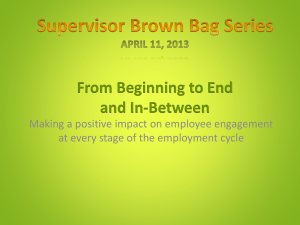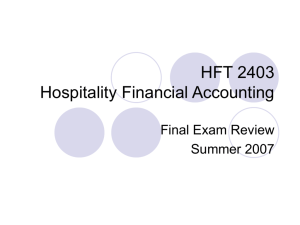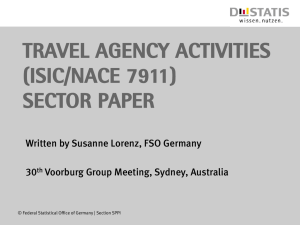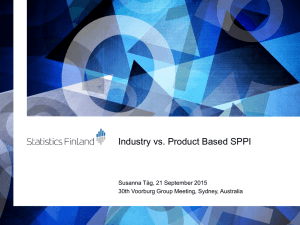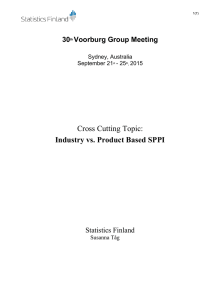30th Voorburg Group Meeting Sector Paper: Call Centres
advertisement
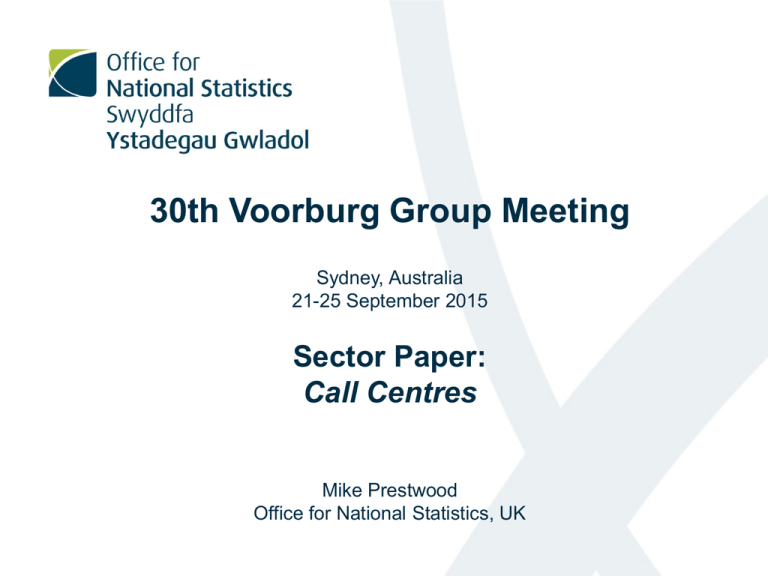
30th Voorburg Group Meeting Sydney, Australia 21-25 September 2015 Sector Paper: Call Centres Mike Prestwood Office for National Statistics, UK Overview • • • • • • Introduction Classifications Status Turnover Services Producer Price Indices (SPPI) Summary Introduction • Output of Call Centres presents few challenges • The sector is well defined and reasonably homogeneous • Production of indices measuring price development is less straightforward, and only a few countries where progress has been made • Summary of experiences of Australia, France, Norway, Sweden and USA • Outline areas for further discussion Classifications • Not significant differences in the classification of the sector across countries • Call Centre covers a reasonably narrow spectrum of services provided almost exclusively to business customers Classifications - Industry Classification Section ISIC Rev. 4 / NACE N – Admin & Rev.2 support service activities NAICS US 2012 56 – Admin & Support and Waste Management & Remediation Services Division Sub-division 82 – Office administrative, office support and other business support activities 82.1 (office admin support activities) 82.2 (activities of call centres) 561 – Admin & Support Services • The only notable difference between classifications is software publishers ANZIC 2006 N – Administrative and support services 72 – Admin services 5614 (business support services) 56142 (telephone Call Centres) 561421 (telephone answer services) 561422 the (telemarketing Bureaus & other contact centres) 729 (other admin services) 7294 (call centre operation) Classifications - Products • Central Product Classification (CPC) v.2 • Classification of Products by Activity (CPA 2008) • North American Product Classification System (NAPCS) v.1 • Distinction made between inbound and outbound call centres and the different services they provide • NAPCS is more detailed than the other 2, with regional differences evident – Canadian variant has 5 products, USA has 6 and Mexico 9 • Norway division 82 has a dominant group 82.9 (business support service activities not elsewhere classified) – maybe a classification issue Status – ISIC 3312 ISIC 3312 Survey Categories Number of Countries a. PPI details >= CPC 0 b. PPI details >= CPC soon 0 c. Turnover details >= CPC 2 d. Turnover details >= CPC soon 0 e. Industry prices calculated 3 f. Industry turnover collected 19 1. Detailed turnover and prices well aligned 0 2. Detailed turnover and prices well aligned soon 0 3. Industry level turnover and prices aligned 2 4. Industry level turnover and prices aligned soon 2 5. Other - no industry coverage for prices and/or turnover, etc. 22 Turnover – Data availability • Good availability – 19 countries compile industry level turnover • Call centre sector accounts for a small proportion of total national output • The industry has a high level of fragmentation – with a large number of small firms for the countries included • However, a small number of large firms companies typically dominate the market Turnover – Data collection • Variety of sources used – sample surveys, censuses and administrative data • Annual surveys to compile turnover data, which also provide additional characteristics data • Sub-annual mostly from surveys, although administrative records being explored more for compliance burden reasons. • Sub-annual results are generally published as indices Turnover – Data issues • Wide range of turnover data available collected on quarterly/annual basis • Less collected on a monthly basis, and detail required for National Accounts met by ‘keys’ derived from more detailed annual surveys • US – quarterly data benchmarked to annual data, for consistent results over time Options for developing turnover statistics for Call Centre Services Category Data Source Frequency Cost Comment Survey/Census Level of Detail Collected Industry turnover and product turnover detail Best Annual and/or subannual collection - Most expensive - Largest response burden - Allows greatest flexibility to identify specific revenue streams - Timely data Good Survey/Census Industry detail only Annual and/or subannual collection - Expensive - High response burden Minimum Administrative data Industry detail only Annual - Least expensive - Little or no respondent burden - Industry level detail may not be sufficient due to secondary activity issues. - Less timely data for Census - Least timely - Units may be misclassified to incorrect industry - Requires interventions to match to register - May be problems around access SPPI Data (1) Data availability • Good availability, although unlikely to be a standard pricing mechanism for the whole sector • Only 3 countries calculate industry level prices Sources of SPPI data • Dedicated SPPI surveys • CPIs cannot be used as a proxy, as call centres confined to commercial sector Target coverage • All of the services that the sector provides – inc. inbound and outbound traffic & on- and off-shore services SPPI Data (2) Pricing methods used and main issues • Unit price measurement is most common with prices based on a minute, hour or productive time. • Unlikely to be a single, standard pricing mechanism used • Price depends on length of call, worked time, productive time, in/out bound call, type of query, time of call, qualification level of employee • Key to distinguish between in-house, outsource & on- and off-shore services • Geographical factors – location of a product affects price SPPI Data (3) Pricing methods used and main issues • Pros & cons of outsourcing : price versus quality : double counting ? : are off-shore services considered as imports ? • Quality adjustments are a challenge – : France says off-shore 80% of on-shore : standardised service should be identified which is representative – may need updating or replacing periodically Weights • Type of weights will vary according to the type of approach taken to compile the PPI • ‘Product’ level prices indices recommended over industry level indices • But, so few countries are producing a price index, that cannot assess the impact of different approaches Options for developing SPPIs for Call Centre Services Service Type Pricing Mechanism Pricing Method Data type in survey Quality and accuracy Routine, repeatable Price per minute/hour of phone time for different levels of employee expertise Contract price Real transaction prices High if transactions remain representative and at constant quality, possibly need to control for time of day Unique and nonrecurring Total price charged for a set contract Contract price Real transaction price High at the beginning but measures of change difficult to capture without an attempt at quality adjustment; this is difficult to achieve. So quality will diminish Summary • Measurements of output development of Call Centres are well developed, but not so prices • International classifications are well harmonised • Call centres as a sector are well defined and NACE and ANZSIC only include one four-digit class. • Mainly, the market is dominated by a few large firms – with units normally homogeneous • Wide range of turnover data available – but only a few countries produce SPPIs • Overlaps between this sector and telecoms – highlighting interdependence within the service sector • Outsourcing a big issue, and quality adjustments an aspect for this




